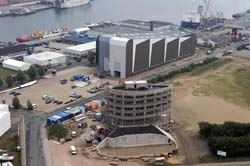Fraunhofer IWES ready for testing XXL rotor blades

Long, longer, the longest: the new test stand allows rotor blade testing on a new scale.<br>Wolfhard Scheer<br>
The construction work took one and half years and the new 20,000 square meter facility doubles the existing capacity for testing complete rotor blades. A tiltable mounting block allows full bending of the blade tips, even for very long rotor blades, and also facilitates the mounting process. The new building represents an investment of 11 million euros and will make a key contribution to assuring the quality of rotor blade prototypes.
A test facility for heavy loads on sandy soil directly at the water’s edge – this was the starting situation for an extraordinary challenge. When the 200 foundation piles were positioned in January 2010 shortly after the first spade of soil was removed, the construction site looked like the excavation works for an ancient temple. A mounting block weighing 1000 metric tons and load transference of up to 500 kN per load point, which is applied to the rotor blade during testing, make this structure necessary.
Fraunhofer IWES has built a unique testing facility at its site in Bremerhaven that allows rotor blade prototypes to be subjected to very realistic loads. The facility was funded by the Federal Ministry for the Environment, Nature Conservation and Nuclear Safety (BMU), the Fraunhofer-Gesellschaft, the State of Bremen, and the European Fund for Regional Development (EFRD). The rotor blade tests deliver, in accordance with IEC requirements, meaningful statements in just a few months about whether a rotor blade can withstand a service life of 20 years undamaged. Compared to the existing testing hall for 70 meter blades, which has been in operation since 2009 and is already operating at full capacity, the new facility not only provides the space for very long rotor blades to be tested but also features a tiltable mounting block.
As this huge steel block can assume an angle of tilt of up to 20 degrees, the tips of even very large blades can be bent by 30 meters. The block also facilitates the mounting of the rotor blades. With the ability to test rotor blades that are, for example, being designed for large 10 MW wind turbines, Fraunhofer IWES is well equipped for the future: “This 90 meter test facility will certainly see us through the coming years and takes into account the current trend towards large rotor blades“, says Prof. Dr. Andreas Reuter, Director of the Fraunhofer IWES in Bremerhaven. Instead of having large generators, the focus will be on larger rotors. This will allow more hours of operation at full load and this is the reason for the change in emphasis, explains Reuter. The main challenge here is to realize aerodynamic efficiency without notable extra weight and additional costs.
The requirements of industry have been taken into account in the design of the test stand: A steering committee, comprising representatives from industry, have supervised the project from the initial planning stage right through to the operational phase. For example, new combinations of materials and new rotor blade designs can now be tested before they are taken into series production. This work is often also undertaken via publicly funded research projects. “We are developing innovative testing and monitoring methods that demonstrate to customers how rotor blades perform under realistic loads,” explains Dr. Arno van Wingerde, Head of the Competence Center for Rotor Blades at Fraunhofer IWES.
The first test began just a few days after the celebration to mark the start-up of operations. As the new test stand is already in high demand, the next expansion step is not long away: This autumn another mounting block will be installed in the 90 meter testing hall.
Media Contact
More Information:
http://www.iwes.fraunhofer.deAll latest news from the category: Power and Electrical Engineering
This topic covers issues related to energy generation, conversion, transportation and consumption and how the industry is addressing the challenge of energy efficiency in general.
innovations-report provides in-depth and informative reports and articles on subjects ranging from wind energy, fuel cell technology, solar energy, geothermal energy, petroleum, gas, nuclear engineering, alternative energy and energy efficiency to fusion, hydrogen and superconductor technologies.
Newest articles

High-energy-density aqueous battery based on halogen multi-electron transfer
Traditional non-aqueous lithium-ion batteries have a high energy density, but their safety is compromised due to the flammable organic electrolytes they utilize. Aqueous batteries use water as the solvent for…

First-ever combined heart pump and pig kidney transplant
…gives new hope to patient with terminal illness. Surgeons at NYU Langone Health performed the first-ever combined mechanical heart pump and gene-edited pig kidney transplant surgery in a 54-year-old woman…

Biophysics: Testing how well biomarkers work
LMU researchers have developed a method to determine how reliably target proteins can be labeled using super-resolution fluorescence microscopy. Modern microscopy techniques make it possible to examine the inner workings…





















